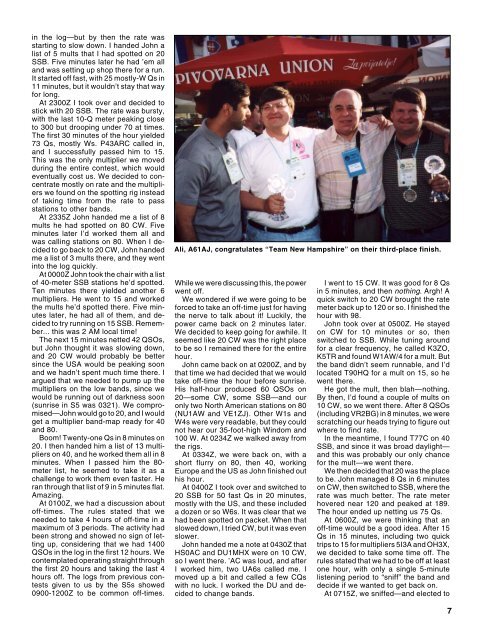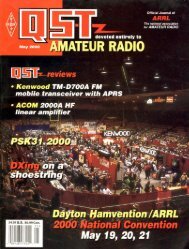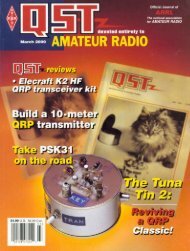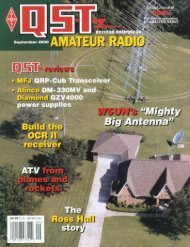September/October 2000 NCJ
September/October 2000 NCJ
September/October 2000 NCJ
Create successful ePaper yourself
Turn your PDF publications into a flip-book with our unique Google optimized e-Paper software.
in the log—but by then the rate wasstarting to slow down. I handed John alist of 5 mults that I had spotted on 20SSB. Five minutes later he had ’em alland was setting up shop there for a run.It started off fast, with 25 mostly-W Qs in11 minutes, but it wouldn’t stay that wayfor long.At 2300Z I took over and decided tostick with 20 SSB. The rate was bursty,with the last 10-Q meter peaking closeto 300 but drooping under 70 at times.The first 30 minutes of the hour yielded73 Qs, mostly Ws. P43ARC called in,and I successfully passed him to 15.This was the only multiplier we movedduring the entire contest, which wouldeventually cost us. We decided to concentratemostly on rate and the multiplierswe found on the spotting rig insteadof taking time from the rate to passstations to other bands.At 2335Z John handed me a list of 8mults he had spotted on 80 CW. Fiveminutes later I’d worked them all andwas calling stations on 80. When I decidedto go back to 20 CW, John handedme a list of 3 mults there, and they wentinto the log quickly.At 0000Z John took the chair with a listof 40-meter SSB stations he’d spotted.Ten minutes there yielded another 6multipliers. He went to 15 and workedthe mults he’d spotted there. Five minuteslater, he had all of them, and decidedto try running on 15 SSB. Remember...this was 2 AM local time!The next 15 minutes netted 42 QSOs,but John thought it was slowing down,and 20 CW would probably be bettersince the USA would be peaking soonand we hadn’t spent much time there. Iargued that we needed to pump up themultipliers on the low bands, since wewould be running out of darkness soon(sunrise in S5 was 0321). We compromised—Johnwould go to 20, and I wouldget a multiplier band-map ready for 40and 80.Boom! Twenty-one Qs in 8 minutes on20. I then handed him a list of 13 multiplierson 40, and he worked them all in 8minutes. When I passed him the 80-meter list, he seemed to take it as achallenge to work them even faster. Heran through that list of 9 in 5 minutes flat.Amazing.At 0100Z, we had a discussion aboutoff-times. The rules stated that weneeded to take 4 hours of off-time in amaximum of 3 periods. The activity hadbeen strong and showed no sign of lettingup, considering that we had 1400QSOs in the log in the first 12 hours. Wecontemplated operating straight throughthe first 20 hours and taking the last 4hours off. The logs from previous contestsgiven to us by the S5s showed0900-1200Z to be common off-times.Ali, A61AJ, congratulates “Team New Hampshire” on their third-place finish.While we were discussing this, the powerwent off.We wondered if we were going to beforced to take an off-time just for havingthe nerve to talk about it! Luckily, thepower came back on 2 minutes later.We decided to keep going for awhile. Itseemed like 20 CW was the right placeto be so I remained there for the entirehour.John came back on at 0200Z, and bythat time we had decided that we wouldtake off-time the hour before sunrise.His half-hour produced 60 QSOs on20—some CW, some SSB—and ouronly two North American stations on 80(NU1AW and VE1ZJ). Other W1s andW4s were very readable, but they couldnot hear our 35-foot-high Windom and100 W. At 0234Z we walked away fromthe rigs.At 0334Z, we were back on, with ashort flurry on 80, then 40, workingEurope and the US as John finished outhis hour.At 0400Z I took over and switched to20 SSB for 50 fast Qs in 20 minutes,mostly with the US, and these includeda dozen or so W6s. It was clear that wehad been spotted on packet. When thatslowed down, I tried CW, but it was evenslower.John handed me a note at 0430Z thatHS0AC and DU1MHX were on 10 CW,so I went there. ’AC was loud, and afterI worked him, two UA6s called me. Imoved up a bit and called a few CQswith no luck. I worked the DU and decidedto change bands.I went to 15 CW. It was good for 8 Qsin 5 minutes, and then nothing. Argh! Aquick switch to 20 CW brought the ratemeter back up to 120 or so. I finished thehour with 98.John took over at 0500Z. He stayedon CW for 10 minutes or so, thenswitched to SSB. While tuning aroundfor a clear frequency, he called K3ZO,K5TR and found W1AW/4 for a mult. Butthe band didn’t seem runnable, and I’dlocated T90HQ for a mult on 15, so hewent there.He got the mult, then blah—nothing.By then, I’d found a couple of mults on10 CW, so we went there. After 8 QSOs(including VR2BG) in 8 minutes, we werescratching our heads trying to figure outwhere to find rate.In the meantime, I found T77C on 40SSB, and since it was broad daylight—and this was probably our only chancefor the mult—we went there.We then decided that 20 was the placeto be. John managed 8 Qs in 6 minuteson CW, then switched to SSB, where therate was much better. The rate meterhovered near 120 and peaked at 189.The hour ended up netting us 75 Qs.At 0600Z, we were thinking that anoff-time would be a good idea. After 15Qs in 15 minutes, including two quicktrips to 15 for multipliers 5I3A and OH3X,we decided to take some time off. Therules stated that we had to be off at leastone hour, with only a single 5-minutelistening period to “sniff” the band anddecide if we wanted to get back on.At 0715Z, we sniffed—and elected to7
















